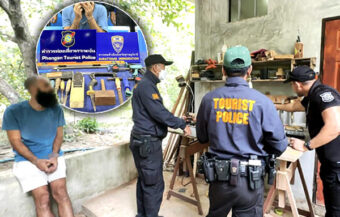Rising ‘Water of Death’ floods Songkhla and Hat Yai and southern provinces. 1.9 million affected, water up to four metres high, worst in 300 years, emergency Level 4 declared, streets and homes submerged, rescue teams struggle, authorities coordinate amid historic deluge.
On Tuesday, Prime Minister Anutin Charnvirakul raised the emergency level in Songkhla and the city of Hat Yai to Disaster Level 4 after flooding worsened sharply since Sunday evening. Southern Thailand is now under widespread flooding that affects 1.3 million people. However, the focus is on 300,000 residents in Songkhla and about 150,000 in central Hat Yai, where water continues to rise and has reached heights of up to four metres. Some observers already describe the event as the ‘Water of Death’ or the worst flooding in 300 years.

Prime Minister Anutin Charnvirakul raised the disaster level in Songkhla Province to Level Four on Tuesday as floodwaters continued to spread across the South. The order covers Hat Yai, the region’s largest city.Level Four requires evacuation, although it stops short of a red notice. The decision followed a rapid deterioration in local conditions. Water levels rose across urban zones and cut access to major roads. Emergency teams warned that some areas were becoming unreachable.
However, rising water was only one part of the problem. Almost the entire southern region faced flooding after days of heavy rain. According to the Department of Disaster Prevention and Mitigation, 1.9 million people have been affected. The scale spans 10 provinces, 92 districts, and more than 4,100 villages. Moreover, new waves of runoff continued to arrive from mountain zones. This runoff drove fresh surges into rivers, canals and residential districts.
Runoff from mountain zones intensifies flooding as 1.9 million people face worsening southern disaster
Conditions in Hat Yai worsened sharply on Sunday night. Unprecedented rainfall hit the mountains east of the city. Water then travelled downhill at speed. It moved directly toward the urban core rather than through diversion canals that had relieved pressure for years.
This shift left Hat Yai exposed. Communities were flooded within hours. Some residents reported water entering homes without warning.
Meanwhile, political tension spread within the government. Deputy Prime Minister Thamanat Prompow did not appear for a scheduled live-link briefing on the crisis. He also serves as Minister of Agriculture and heads the Kla Tham Party.
Later reports placed him in Chiang Mai. Officials offered no detailed explanation. The absence coincided with a worsening emergency and rising public pressure for faster action.
Additionally, flooding spread through northern and central Thailand. Eleven provinces there reported swollen rivers and damaged infrastructure. Authorities say levels are receding but stress that more than 480,000 people remain affected. Yet the South faces the most serious impact this year. Water is still rising in several districts.
Rising flood levels expose Hat Yai communities while political tensions grow in crisis response
The floods also carry political consequences. Southern MPs may influence the balance of power in the 2026 General Election. Although the region has long supported conservative parties, the People’s Party and Pheu Thai Party have made inroads.
Next year, Bhumjaithai, Kla Tham and the Democrat Party aim to expand support. The scale of the disaster and the government’s performance may shape those outcomes.
On November 25, Prime Minister Anutin signed Prime Ministerial Order No. 10/2025. It raised Songkhla’s status to a Level Four disaster zone. It also created the National Disaster Prevention and Mitigation Command. The Command is based at the Department of Disaster Prevention and Mitigation.
It will coordinate all agencies, including provincial administrations, security forces, and volunteer groups. The order cites Section 11 of the Disaster Prevention and Mitigation Act of 2007. It allows rapid action, unified command, and emergency compensation. The order took effect immediately.
Hat Yai reaches historic flood levels as seawater, monsoon rain and mountain runoff submerge streets
By Tuesday, conditions in Hat Yai have reached historic severity. Seawater from the Gulf of Thailand combined with monsoon rain and mountain runoff. Streets and markets disappeared under rising water. Some residents called the event the “Water of Death.” Meanwhile, several academics warned that the scale resembled floods recorded hundreds of years ago.
In early November, a cold air mass from China moved south. It produced continuous rain across Songkhla, Yala, and Pattani. People are accustomed to year-end rain. However, this year’s rainfall was unusually intense and sustained. Water accumulated in upstream zones for days. Soil saturation increased runoff. Canals began to overflow.
From November 15 to 18, heavy rain fell on Sadao District, Khlong Hoi Khong, and the Sankalakhiri mountain range. U-Tapao Canal levels rose quickly. At the same time, high tide slowed drainage into the Gulf.
As a result, water backed up into populated areas. Khlong Hoi Khong overflowed first. Communities in Khlong Hae, Khlong Wa, and Khuan Lang reported rising water. Roads became blocked. Residents began moving valuables to higher floors.
Main roads turn into rivers as Hat Yai sees flooding of homes, hospitals and schools amid chaos
Between November 20 and 22, the situation escalated. Main roads in Hat Yai turned into fast-moving channels. Phetkasem Road, Niphat Songkhro Road and Kanchanawanit Road are all flooded. Power cuts followed in several zones due to the risk of electric shock. Businesses closed. Schools suspended operations. Emergency units struggled to navigate submerged intersections.
On November 23, water entered the city centre. Depth reached one to two meters in several districts. Hospitals, schools, and government buildings were affected. Medical teams transferred some patients to higher floors. Residents used boats to move between streets. Some communities became isolated.
Satellite data released on November 24 confirmed the scale. GISTDA used Sentinel-1A images and the HAND model to analyse flood depth. Most of Hat Yai was in the “dark blue zone,” indicating two to three meters of water. Some “very dark” areas exceeded four meters. More than 150,000 residents were affected. At least 25,102 homes sustained damage. More than 536 kilometres of roads were affected. Dozens of schools and hospitals reported severe disruption.
Crisis peaks as Hat Yai residents are stranded with water levels continuing to rise at this time
By November 25, the crisis had not yet peaked. Runoff continued to push toward the city. Drainage remained slow due to high sea levels. Many residents were stranded on the upper floors of homes. Rescue teams moved by boat and military truck. Supplies dwindled in some communities. Officials warned that water levels might reach 1.25 to 1.45 meters on the morning of November 25. Peak levels were expected at about 6 a.m.
Experts compared the flood to major events in 1978 and 2000. Some warned that the 2025 flood may be equal to or worse than those. The severity may rank among the most damaging in centuries. Economic losses in Songkhla already exceed ฿500 million.
According to the Smart Water Operation Centre, the South has been under a monsoon trough and low-pressure cell since November 19. Heavy rain covered all districts of Songkhla. Hat Yai recorded 335 millimetres of rain on November 21. Officials say this is the heaviest daily total in 300 years. Additionally, the basin received further rainfall through November 23.
U-Taphao Canal surges overwhelm Hat Yai drainage as experts warn of historic flooding in the South
Runoff from the U-Taphao Canal surged toward Hat Yai late on November 23. More rain fell across the basin. Water levels climbed continuously through the night. DDPM repeated its highest alerts and instructed at-risk communities to evacuate.
Environmental expert Sonthi Kotchawat described the flood as one of the worst natural disasters in recent years. All 16 districts of Songkhla Province are flooded. About 150,000 households were impacted. Hat Yai suffered its worst flooding since 2000. Moreover, water continued to rise in some zones as of late November.
Sonthi cited topographic factors. Hat Yai sits on low ground that slopes toward Songkhla Lake. When lake levels rise, drainage slows. The U-Taphao Canal runs 116 kilometres from Sadao through Hat Yai. It funnels water from multiple tributaries. The R.1 Canal, developed after the 2000 flood, diverts water to accelerate drainage. However, runoff also arrives from Khao Kho Hong and the Nakhon Si Thammarat range. All flows tend to converge before exiting toward the lake.
Record rainfall and La Niña conditions worsen flood impact as emergency services struggle to respond
Weather intensified the situation. A high-pressure system from China combined with a low-pressure trough and La Niña conditions. Rain fell for days without breaks. Between November 19 and 22, rainfall reached 595 millimetres. This exceeded historic totals from 2000 and 2010. Khao Kho Hong recorded 365 millimetres on November 22 alone. Water overwhelmed drainage and then spilt into Hat Yai’s core.
Sonthi also noted a slow emergency response. Alerts were issued one to two days in advance. However, rescue operations struggled. Many residents remained stranded. Supplies were difficult to deliver. Roads were cut off by fast-moving water.
Dr. Somporn Chuayaree of Prince of Songkla University said this year’s pattern differed from past floods. After 2000, the R.1 diversion canal eased pressure from upstream districts. But this year, the heaviest rainfall struck Khao Kho Hong. That area drains directly into Hat Yai. It does not enter the diversion canal. Water then moved down steep slopes and into urban communities.
Escalating disaster with continuous rainfall, rising runoff and widespread urban flooding
Throughout November, the escalation followed a clear sequence. First came continuous rain. Then runoff rose in mountain zones. Next, drainage slowed as sea levels increased. Satellite data confirmed widespread inundation. Roads disappeared under water. Hospitals struggled to maintain operations. Tens of thousands of homes were affected. And finally, runoff continued to move toward Hat Yai even as the city issued evacuation orders.
The 2025 flood now stands as one of the defining emergencies of the year. The event demonstrates the region’s vulnerability to heavy rain, high tides, and rapid runoff.
Northern Mekong River provinces battling the most severe flooding in 40–50 years after massive rainfall
Mr Bin and the Prime Minister working together to bring relief as authorities battle flooding
Authorities are still focused on evacuation, rescue, and emergency coordination. The problem for Prime Minister Anutin Charnvirakul is that many people have not yet been reached by rescue services. At the same time, the flooding continues with no signs of water levels receding.
Local people are certainly worried right now about the rising ‘Waters of Death’ as they scramble to escape the deluge. In the meantime, the armed forces have been deployed, including the army, air force, and navy, to respond to a still-emerging crisis. As to the ultimate cost in terms of lives, property damage, and political capital, that must wait until the water abates.
Join the Thai News forum, follow Thai Examiner on Facebook here
Receive all our stories as they come out on Telegram here
Follow Thai Examiner here
Further reading:
People’s Party on campaign but on guard against potential legal complaints to oversight agencies
Wealthy young People’s Party leader aims to create a technology-driven and efficient welfare state
Inward immigration may ultimately be the only thing that can halt Thailand’s fated economic decline
Thailand’s days of GDP growth in excess of 5% may be a thing of the past as it has grown too old
Cabinet in pension move as the number of working Thais to over 60s is set to half in 20 years
Thailand’s new move to boost the birth rate and fight the negative impact of an ageing population
Denmark and Thailand seek economic partnership and face the same challenge – demographics
Thailand’s new move to boost the birth rate and fight the negative impact of an ageing population
BCG economic and social blueprint over the next 5 years unveiled, promises more money for less
Noble spirit of Thailand’s elderly helps country deal with demographic problem


















